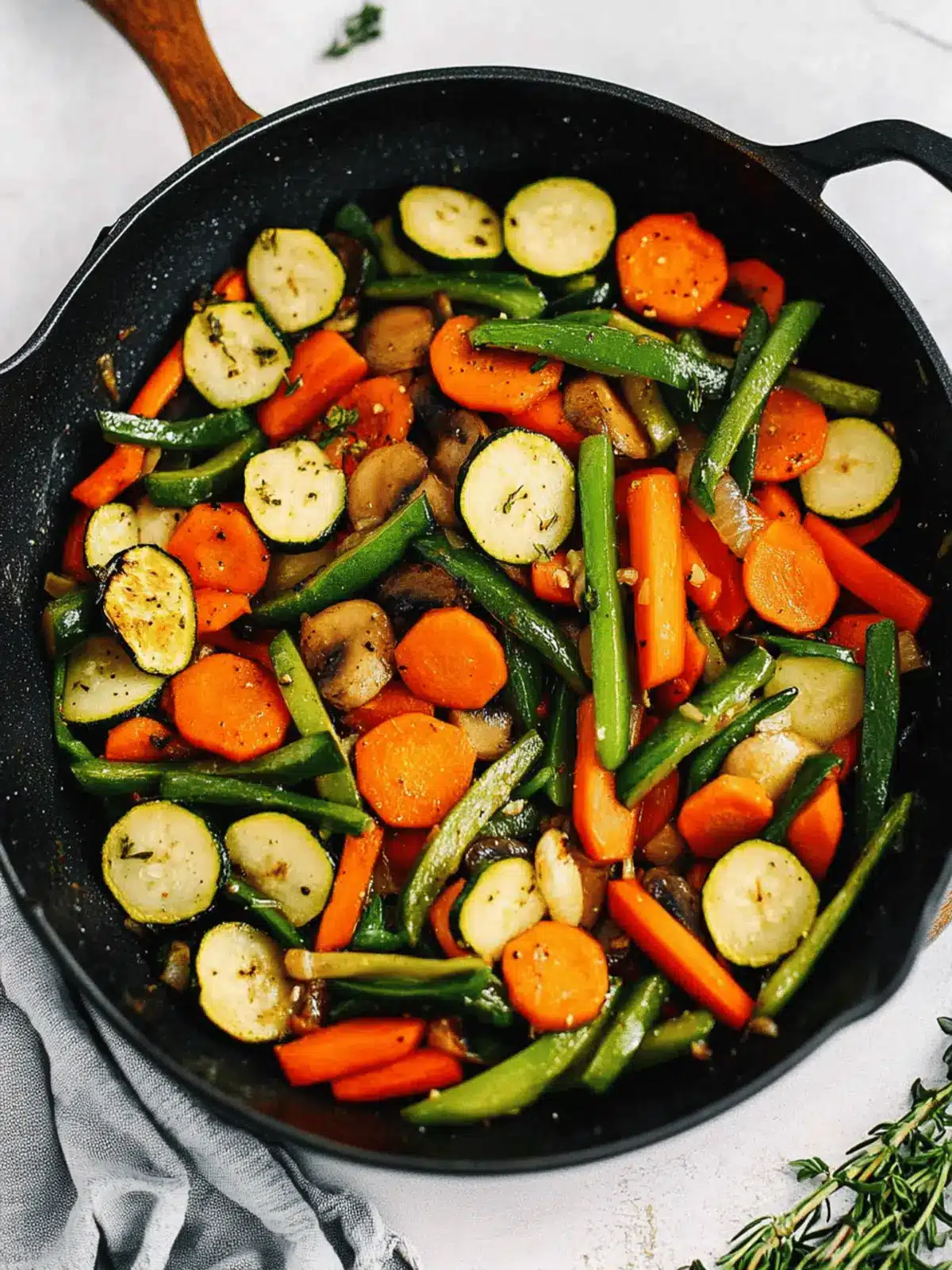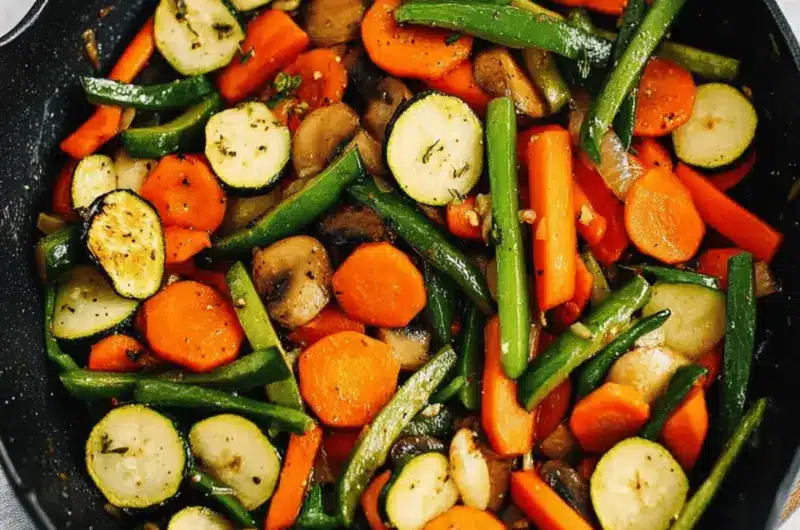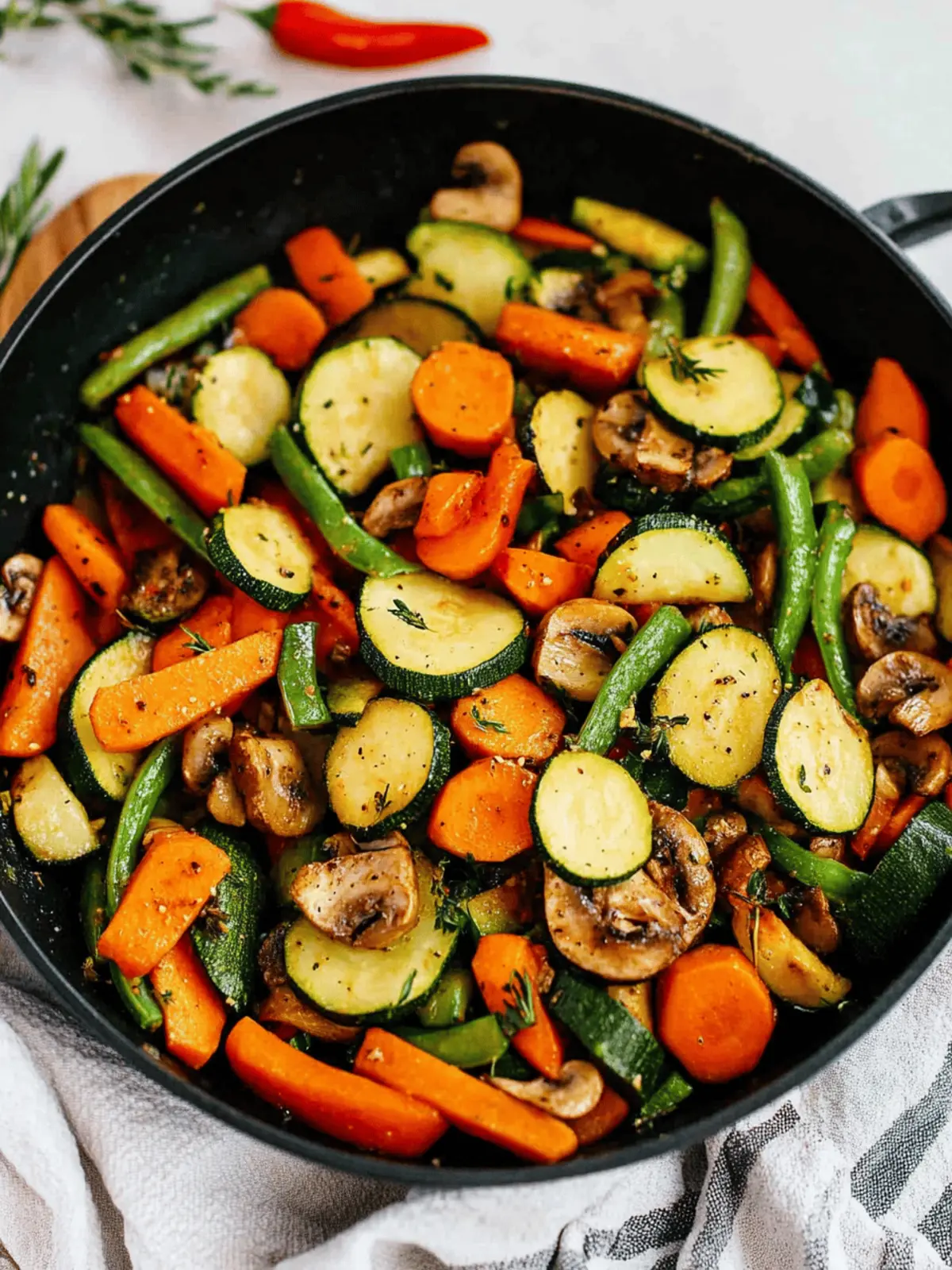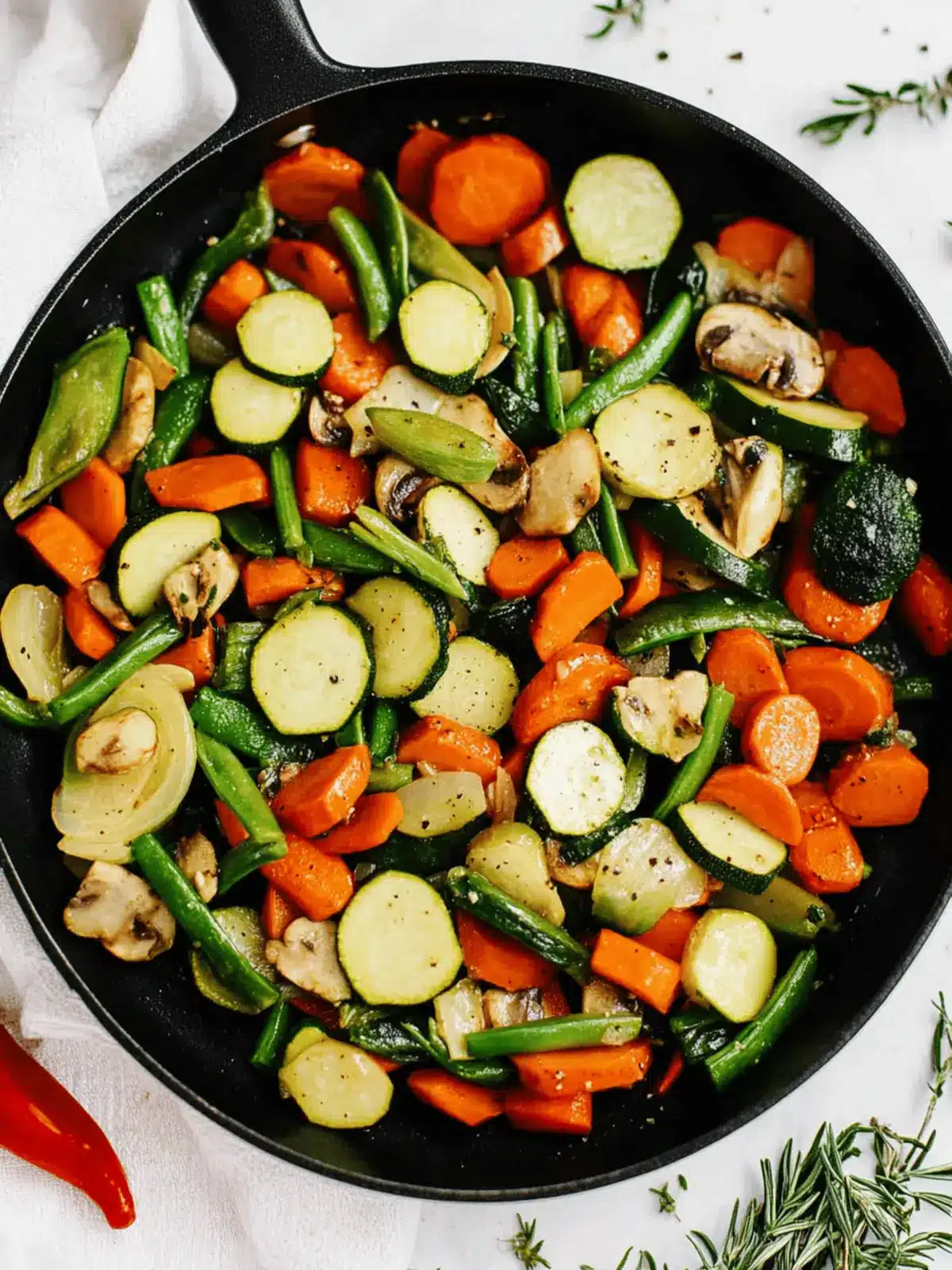After a whirlwind week filled with meetings and takeout dinners, I craved something vibrant and fresh to reset my food routine. That’s when I rediscovered my love for Healthy Sautéed Vegetables—a quick dish that not only packs a punch of flavor but also brings a rainbow of nutrients to the table. As I diced crisp bell peppers, sweet zucchini, and bright broccoli, the sizzle of garlic in olive oil instantly lifted my spirits.
This recipe is my go-to for those busy nights when you want to indulge in homemade goodness without spending hours in the kitchen. With just a handful of ingredients and some simple techniques, you can create a satisfying meal that pleases both the palate and the eye. Perfect for a family dinner or as a colorful side at your next gathering, these sautéed veggies promise to elevate your plate and bring joy back to your cooking. Let’s dive into this delightful medley!
Why are Healthy Sautéed Vegetables a Must-Try?
Vibrant colors: The mix of bell peppers, zucchini, and broccoli creates a beautiful dish that’s pleasing to the eye.
Quick and easy: With a total time of just 22 minutes, you can whip this up on a busy weeknight.
Nutritious goodness: Packed with vitamins, this recipe helps you meet your daily veggie intake.
Versatile flavors: Customize with lemon juice or soy sauce to match your taste preferences.
Family-friendly: Everyone loves the satisfying crunch and freshness, making it perfect for dinner parties or casual nights in. You could also serve it alongside grilled chicken for a complete meal!
Healthy Sautéed Vegetables Ingredients
Unlock the secrets to crafting these delightful Healthy Sautéed Vegetables with just a few simple ingredients!
For the Sauté
• Olive oil – A heart-healthy fat that adds richness and helps sauté the veggies perfectly.
• Garlic – Minced for aromatic flavor; it’s the secret to elevating your dish’s essence.
• Onion – Thinly sliced for sweetness and a savory base that complements every vegetable.
For the Veggies
• Bell pepper – Sliced for a sweet crunch; choose vibrant colors for a more colorful dish.
• Zucchini – Sliced into half-moons to absorb those delicious flavors while staying tender.
• Broccoli florets – These little green trees add texture and health benefits to your meal.
• Carrot – Julienned or sliced thin, it brings a natural sweetness and lovely color.
• Snap peas – Sweet and crisp, they provide a delightful pop of freshness.
• Mushrooms – Sliced for an umami richness that balances the other veggies perfectly.
Seasoning
• Salt and black pepper – Essential for enhancing the flavors; taste as you go!
• Lemon juice (optional) – A splash at the end brightens the dish and adds zing.
• Balsamic vinegar or soy sauce (optional) – Choose one for added depth of flavor that pairs beautifully with the vegetables.
How to Make Healthy Sautéed Vegetables
-
Prepare the Veggies: Wash, peel (if necessary), and cut all vegetables into uniform pieces to ensure even cooking. This will make your dish look appealing and allow the flavors to meld beautifully!
-
Heat the Skillet: Place your skillet over medium-high heat and pour in the olive oil. Let it heat for a moment until shimmering to create the perfect base for your sautéed vegetables.
-
Sauté Aromatics: Add the minced garlic and thinly sliced onions to the skillet. Sauté for 1–2 minutes until fragrant, filling your kitchen with an irresistible aroma that hints at the delicious meal to come.
-
Add First Veggies: Toss in the julienned carrots and broccoli florets first. Cook for 3–4 minutes, stirring frequently, until they are just tender. This step ensures they start to soften while still retaining their vibrant colors.
-
Mix in Remaining Veggies: Gently add the sliced bell peppers, zucchini half-moons, snap peas, and mushrooms into the skillet. Sauté for another 4–5 minutes until everything is crisp-tender and the colors brighten beautifully!
-
Season to Taste: Sprinkles of salt and black pepper will enhance the flavors. If desired, add lemon juice or balsamic vinegar/soy sauce at this stage for that extra zing—just toss everything well to coat.
-
Serve and Garnish: Toss the veggies one last time to ensure they’re well mixed, then serve immediately for the best texture. Garnish with fresh herbs, seeds, or nuts for that extra touch!
Optional: For added crunch, sprinkle some toasted sesame seeds before serving.
Exact quantities are listed in the recipe card below.
Healthy Sautéed Vegetables Variations
Feel free to get creative and tailor this recipe to your taste buds, adding your unique flair!
- Dairy-Free: Swap traditional butter for olive oil or vegan butter for a creamy finish without dairy.
- Spicy Kick: Add sliced jalapeños or a sprinkle of red pepper flakes during the sauté for a fiery burst of flavor.
- Herb Infusion: Toss in fresh herbs like basil, thyme, or parsley at the end for an aromatic twist that elevates the dish.
- Crunchy Toppings: Sprinkle toasted nuts, sunflower seeds, or pumpkin seeds on top to add texture and nutty flavors.
- Flavorful Broth: Use vegetable or chicken broth instead of oil for sautéing to infuse the veggies with extra depth and richness.
- Additional Veggies: Incorporate seasonal vegetables like asparagus or eggplant for variety and to keep it exciting throughout the year. This allows your dish to be as unique as your palate!
- Grain Base: Serve the sauté over quinoa, rice, or couscous for a hearty meal that’ll fill you up while keeping it nutritious.
- Citrus Zest: Include zest from lemon or lime during cooking for a refreshing, zingy brightness that perfectly complements the vegetables.
What to Serve with Healthy Sautéed Vegetables?
Elevate your meal with delicious sides that complement the vibrant flavors and textures of sautéed veggies.
- Quinoa Pilaf: This nutty grain adds protein and pairs well with sautéed vegetables’ fresh crunch.
- Garlic Bread: Crispy and buttery, it’s perfect for soaking up any remaining flavors on your plate.
- Grilled Chicken: Juicy and tender, it brings warmth and substance, making it a fantastic protein partner.
- Fresh Mixed Salad: A light salad with citrus dressing enhances the freshness of your sautéed vegetables.
- Brown Rice: Whole grain rice offers a wholesome base with earthy flavor, balancing perfectly with the dish.
- Pasta Primavera: Tossed with olive oil and herbs, it echoes the colors of the veggies while adding heartiness.
- Herbed Couscous: Light and fluffy, couscous can soak up the essence of the veggies, creating a harmonious meal.
- Crisp White Wine: A chilled glass of Sauvignon Blanc or Pinot Grigio complements the dish’s freshness beautifully.
- Chocolate Mousse: For a sweet finish, this rich dessert provides a delightful contrast to the savory sauté.
- Fruit Sorbet: A refreshing palate cleanser, the fruity notes will brighten up your meal’s finale.
How to Store and Freeze Healthy Sautéed Vegetables
Fridge: Store leftover Healthy Sautéed Vegetables in an airtight container in the refrigerator for up to 3 days. This keeps them fresh for quick meals throughout the week.
Freezer: For longer storage, place cooled sautéed vegetables in a freezer-safe container or zip-top bag. They can be frozen for up to 2 months, preserving their nutrients and flavor.
Reheating: To reheat, simply microwave them for 1-2 minutes or warm them in a skillet over medium heat until heated through, ensuring they stay crisp and delicious.
Airtight: Always ensure containers are well-sealed to prevent freezer burn, which can affect the texture and taste of your Healthy Sautéed Vegetables.
Tips for the Best Healthy Sautéed Vegetables
-
Uniform Cutting: Ensuring all vegetables are cut into uniform pieces promotes even cooking, preventing some from becoming mushy while others stay raw.
-
High Heat Cooking: Sauté over medium-high heat for that ideal crisp-tender texture. A cooler pan can lead to steaming rather than sautéing.
-
Flavor Timing: Add garlic and onions first to build a flavorful base, avoiding burnt garlic which can make the dish bitter.
-
Season Gradually: Taste as you go; wait until the end to adjust salt and pepper, keeping your Healthy Sautéed Vegetables perfectly seasoned.
-
Optional Add-ins: Try adding protein like chicken or tofu, or enhance with nuts for added texture and nutrition that complements your veggies beautifully!
Make Ahead Options
These Healthy Sautéed Vegetables are perfect for meal prep enthusiasts! You can wash, peel, and chop all your vegetables up to 24 hours in advance, storing them in an airtight container in the refrigerator to maintain freshness. Remember to drizzle a little lemon juice over the cut veggies to prevent browning. For an even quicker option, sauté them in advance and refrigerate for up to 3 days — just reheat in a skillet over medium heat for a few minutes, adding a splash of water if needed to revive their vibrant colors. This way, you can enjoy restaurant-quality sautéed vegetables with minimal effort during busy weeknights!
Healthy Sautéed Vegetables Recipe FAQs
What vegetables should I use for Healthy Sautéed Vegetables?
Absolutely! You can use a variety of vegetables based on your preferences. Fresh options like bell peppers, zucchini, broccoli, carrots, snap peas, and mushrooms work wonderfully. Feel free to experiment with seasonal vegetables, such as asparagus in spring or butternut squash in the fall, to keep things exciting!
How do I store leftovers of Healthy Sautéed Vegetables?
Store any leftovers in an airtight container in the refrigerator for up to 3 days. This helps maintain their freshness and makes for easy meal prep during the week. Reheat them gently in a skillet or microwave, and add a splash of water to keep them moist.
Can I freeze Healthy Sautéed Vegetables?
Yes! To freeze, let the sautéed vegetables cool completely first. Then, transfer them to a freezer-safe container or zip-top bag, removing as much air as possible. You can freeze them for up to 2 months. When you’re ready to enjoy them again, simply thaw overnight in the fridge or reheat directly from frozen in a skillet over low heat until warmed through.
What if my sautéed vegetables start to get mushy?
Very good question! If they become mushy, it’s likely that they’ve been cooked too long or at too low a temperature. Ensure your skillet is hot enough before adding the vegetables and try to sauté in smaller batches if you’re cooking a lot at once. Aim for a crisp-tender texture, which is just enough time to cook them without losing their vibrant crunch!
Are there any common allergens in Healthy Sautéed Vegetables?
The basic recipe is quite allergy-friendly; however, always check with your guests or family members about specific allergies. If you’re concerned about gluten, opt for soy sauce substitutes, like tamari. For dairy allergies, ensure that any garnishes (like seeds or nuts) are safe for the individual dietary needs.
Can I add protein to my Healthy Sautéed Vegetables?
The more the merrier! Adding protein like grilled chicken, shrimp, or tofu can transform this dish into a heartier meal. Just cook the protein separately, then toss it with the sautéed veggies right before serving for an all-in-one delight!

Delicious Healthy Sautéed Vegetables for Vibrant Everyday Meals
Ingredients
Equipment
Method
- Wash, peel (if necessary), and cut all vegetables into uniform pieces to ensure even cooking.
- Place your skillet over medium-high heat and pour in the olive oil. Let it heat until shimmering.
- Add the minced garlic and sliced onions to the skillet. Sauté for 1–2 minutes until fragrant.
- Toss in the julienned carrots and broccoli florets. Cook for 3–4 minutes, stirring frequently.
- Gently add the sliced bell peppers, zucchini, snap peas, and mushrooms. Sauté for another 4–5 minutes.
- Sprinkle with salt and black pepper for flavor. Add lemon juice or balsamic vinegar/soy sauce if desired.
- Toss the veggies one last time before serving immediately, garnished with fresh herbs, seeds, or nuts.










